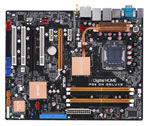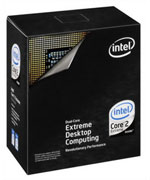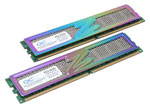Intel Ultra High-End Platform
Finally, we come to the granddaddy of all high-end computer configurations. Oh sure, we could go off the deep end and recommend a dual socket motherboard with Xeon 5160 processors and multiple gigabytes of memory - or you could go out and purchase one of the new Mac systems and get the same thing (minus CrossFire/SLI support) - but outside of workstation class applications a fast single socket configuration will usually offer better performance, and it will save you quite a bit of money.
 |
The MSI motherboard in our basic Intel recommendation is still a good motherboard, and the Abit AW9D and AW9D-Max are another alternative. However, if you want what is considered the best overall 975X motherboard right now, that distinction continues to belong to the ASUS P5W DH Deluxe. Capable of reaching bus speeds of over 400MHz while maintaining stability, and offering full support for 2x8 CrossFire, the ASUS P5W DH has all the features necessary for building an ultimate performance computer. It also fully supports the upcoming Core 2 Extreme QX6700 for those that are planning to upgrade to quad cores in the future. Prices have also come down quite a bit since the initial Core 2 launch, although at $230 the P5W DH certainly isn't an inexpensive motherboard. Thankfully, as the saying goes, you get what you pay for, and what you're paying for here is optimum performance.
 |
When it comes to CPU performance, the Core 2 Extreme X6800 is currently the fastest mainstream processor available. In our initial review, we found that the X6800 didn't lose a single benchmark to any other processor. Similar to AMD's FX series, Core 2 Extreme also comes with unlocked CPU multipliers, so you also gain the benefit of being able to overclock via higher multipliers rather than simply increasing bus speed. (That could prove especially useful if you want to get an nForce4 SLI for Intel motherboard.) If you're interested in achieving maximum performance at any price, you will certainly want the X6800. Just don't get too upset when something faster comes out in the not-too-distant future.
 |
For our ultra high-end configuration, we have pulled out all the stops and gone with some of the fastest memory we have ever tested. The OCZ Titanium VX2 is rated at DDR2-1000, and it is also certified for operation with up to 2.4V. Depending on personal preference, you might also find the chromatic heatsinks to be the best thing ever... or not. In our performance testing, the OCZ VX2 was able to keep up with the best memories currently available. Beyond DDR2-1100, increased latencies often reduce performance making higher clock speeds less useful, but up through DDR2-1067 there are actual performance benefits to be had. Are the benefits worth the extra $150? For a lot of people, the answer is no, but anyone seriously considering a $1000 processor is probably going to want maximum performance in all other areas as well.

 |
Going along with the maximum performance trend, our graphics card selection consists of the recently launched ATI X1950 series, with the obligatory XTX + CrossFire combination. Sporting the same GPU clock speed as the X1900 XTX but utilizing GDDR4-2000 rather than GDDR3-1550, the X1950 is the fastest single GPU currently available. (The GeForce 7950 GX2 is still faster in some situations, but that is technically two GPU cores, and as already mentioned the prospects of upgrading to quad SLI are not without their drawbacks.) ATI's latest driver updates have also further improved performance of all of the R580 cards, with the net result being that X1950 CrossFire is faster than the NVIDIA alternative in most games.
Lastly, we come to the storage subsystem. Anyone looking for even more extreme performance could always add a couple of 150GB Western Digital Raptor drives in RAID 0, but for an ultra high-end computer we prefer more storage over slightly faster hard drives. Thus, we have chosen two 500GB Western Digital hard drives, which you can once again choose to run in RAID 0, RAID 1, or simply as individual drives, giving you up to a full terabyte of storage. You could further upgrade to RAID 1+0 for performance and redundancy, although that would also require four hard drives which is more than most people want to install in a home computer. We certainly aren't recommending this configuration as the best choice for every single person: get what you feel is most beneficial for your storage needs.















45 Comments
View All Comments
JarredWalton - Tuesday, October 10, 2006 - link
Seasonic makes PC Power and Cooling PSUs as far as I'm aware (I've seen it stated elsewhere, though nothing official from either company), along with Silverstone and a few others I believe. (I wouldn't be surprised if some of the other PSU manufacturers re-rate the power supplies to a higher wattage however.) While I'm sure there are some companies that would ask to get a lower cost PSU manufactured, I don't think anyone going to Seasonic is looking at price as a primary concern. I would wager heavily that the components that go inside a Seasonic PSU are identical to the components they put in a PC Power and Cooling PSU -- after all, once you're using the best components available, there's not much else to do. The only difference is that Seasonic uses 120mm fans these days, whereas PC Power and Cooling still uses 80mm fans I believe. (I know which of those two options I prefer!)In terms of efficiency, all of the high-quality PSUs are going to be 80 to 88%. As far as I understand it, the watt rating is still how much power the PSU can output to components, so basically less efficient PSUs will simply run hotter when outputting the same amount of power, and that the same time they will cost more money because they are consuming more power from the outlet. If that's correct, let's do a quick sample calculation:
75% efficiency with a 300W PC draw:
Wall power: 400W
24/7 Operational Cost: $28.80 per month ($.10 per kilowatt)
Yearly Cost: $345.60
85% efficiency with a 300W PC:
Wall power: 353W
24/7 Operational Cost: $25.42 per month ($.10 per kilowatt)
Yearly Cost: $305.04
Savings per year: $40.56
So yes, you can argue that buying high-efficiency power supply can pay for itself over the course of the year. Not that we're comparing a pretty average (75%) power supply a with a very good (85%) power supply, and we're also assuming 24/7 operation at a relatively high load. A lot of computers, including the basic AMD system, probably average closer to half that much power draw.
Something else worth mentioning is that most high-end power supplies -- the type that are supposed to be capable of outputting 700-1000W for example -- often have much lower efficiency ratings when they aren't being heavily loaded. Some PSU companies will actually tell you the efficiency rating at several different loads. Often, you will find that under moderate load even a high-quality 700 W power supply will only be about 70% efficient.
PC Power and Cooling aren't bad PSUs, but they are definitely overpriced relative to other options. Either the best power supply on the market? I don't personally think so, although they are *one* of the best. Given the choice between a high-quality Fotron Source (700 W model for instance) and the competing Seasonic or PC Power and Cooling model, I'm going to save you $50 and go with Fotron Source.
yyrkoon - Friday, October 13, 2006 - link
Well yeah, the more efficient PSU is going to save you money in a few years, but after a point, that doesnt bother me as much as the Typical PSU being rated at 25C. What does this mean? This means, that if ambient (inside the PC case ) is above 10-15C, your PSU, inside, is going to be over 25C, which means, you're going to be losing power, AND efficency.I dont recall the formula, but lets assume you lose 5% power per 5C over the rated maximum tempurature, and the temp inside the PSU is 30C. This basicly means IF your PSU is rated at 600W @ 25C, at 30C, its actually only capable of 570W maximum (continuous). Now, this may look fairly trivial, however, I'm thinking real world, its actually more than 1% loss per 1C.
Anyhow, it doesnt bother me one bit spending $200 us even on a PSU thats going to take care of my current system, and several afterwards.
yyrkoon - Friday, October 13, 2006 - link
PCP&C Started in a garage in 1981 (ish) in California. How long has Seasonic been around ? If you go to PCP&C's website, you can read an article written about how PCP&C got started, and why the owner/president is so 'anal' about certain issues. Some of which, I agree with.It's possible the plant in China that makes Seasonic PSUs also make PCP&C, but I hardly think they are re-branded. This is how it works, everyone (basicly) has thier PSUs made in China to reduce costs, and maximize profits, if someone TRIED starting a PSU manufactuering plant in the US, they would most likley go bankrupt, before they became noticed. Even the PSU companies CLAIMING to be in Tiawan, are actually just 'store fronts' for the actual part being manufactuered in China.
How do I know this you ask ? I've had a lengthy chat with a friend in person, who worked in the buisness, and described to me how it works. From the conversation, I gathered that PCP&C PSUs ARE designed by the US company, and the company also picks out he parts to be used etc, but everything gets sent over to China, is put together, and sent back to be sold. I suppose its even possible that Seasonic is the middle-man in all of this, but I will just about garuntee that the owner of PCP&C retains the IP for his designs, after all, he started off as an un-known Electronics Engineer, making quieter PSUs, that had longer hold up times for friends, before he got into the buisness (or so he claims, but I've zero reason to doubt the guy on his word here).
The way I see it, SOMEONE puts all the parts together, BUT PCP&C still makes thier own PSUs by design/parts.
Again, let me re-iterate, PSU efficeincy has to do with power lost to heat while converting AC -> DC ;)
BladeVenom - Monday, October 9, 2006 - link
I would rather go with the power supplies that you recommended in you midrange buyer's guide. Kingwin doesn't have a good reputation, and the last review I saw for one of their power supplies would make me hesitant to even use it in a low end PC. http://www.jonnyguru.com/PSU/Absolute600W/">http://www.jonnyguru.com/PSU/Absolute600W/Another thing that suprised me was the Bluegears b-Enspirer. It sounds interesting, but I could only find a couple of short reviews for it. Since you're recommending it, are you going to do a review of it soon?
KorruptioN - Monday, October 9, 2006 - link
Agreed. The Kingwin (based on a Superflower) isn't the best choice available. You guys seemed to pick it out based on the fact that it offered "600 Watts". It doesn't even offer a second PCI-E power connection (according to JonnyGURU's review). Combined with the 30A +12V rating, it isn't good enough for dual-GPU configurations, IMO.Antec's NeoHE 500W (in the later revisions) or one of XClio's modular PSUs are better overall choices, I think.
JarredWalton - Monday, October 9, 2006 - link
I'm quite sure that the Kingwin does have dual PCIe plugs: http://www.kingwin.com/pdut_detail.asp?LineID=&...">Specifications. Perhaps JohnnyGuru got an early revision that was messed up - that happens more often than I'd like with hardware review sites, as we often get product before it's publicly available. Obviously, it's the "low-end" of this roundup, which means part of the choice was made for pricing reasons. I guess I forgot to make my standard disclaimer clearly visible:Fotron Source, Seasonic, Enermax, and a variety of other PSU manufacturers (well, a lot of them are just rebranded Fotron Source or some other OEM design) are good choices that will almost always cost a bit more money. For the baseline AMD model, you certainly don't need a 600W PSU. If you're looking to upgrade in the future and keep the PSU, getting something better is recommended.
That said, I'll pop out the Kingwin and put something else in there. I'm not going to go with PCP&C for the price, that's for certain. They make fine power supplies (well, Seasonic does), but while they warrant a mention on the Ultra configuration, they can't really fit into an ~$2000 budget without having to sacrifice other areas just to accommodate a PSU that's overkill. Hopefully you're all happy with spending $35 more to go from an okay Kingwin 600W to a great Seasonic 500W. :)
KorruptioN - Monday, October 9, 2006 - link
Jarred, you're linking to a different PSU altogether. You are linking to the ABT-600MM, where the original PSU selection in this PC guide was the ABT-600CW. It does look like the specification has been updated to include two 6-pin PCI-E power connections, but that doesn't really change the fact that it doesn't have a lot of juice where it matters the most.Either way, good choice on that Seasonic S12-500. How about the new M12-500? Or is that too much to ask :P
JarredWalton - Monday, October 9, 2006 - link
Ah, then the mistake was yours (well, someone's anyway - whoever linked the JohnnyGury review). The original PSU was indeed the Kingwin Maximum Power ABT-600MM 600W -- I have the spreadsheet right in front of me, and I'm sure it was not the CW version. Figures; people like to get up in arms over PSUs, but then they rarely do anything more than say "OMG it's not a Seasonic/[insert favorite brand]!". You can get the ABT-600MM http://www.xpcgear.com/abt600mm.html">right here - that's the price I used in the original text.Gary Key - Monday, October 9, 2006 - link
Yes, we will be reviewing it in the coming weeks. While not in the same class as the X-FI for gaming, it is better than the on-board solutions while providing just about every option you would want in a HTPC card considering the price.
poohbear - Monday, October 9, 2006 - link
hate to point this out about this whole article, but if price was'nt an issue, wouldnt i just buy something prebuilt from falcon northwest, voodoo pc, or alien ware? im not sure which audience this article caters to, but i doubt they're a DIY audience that follows anandtech.